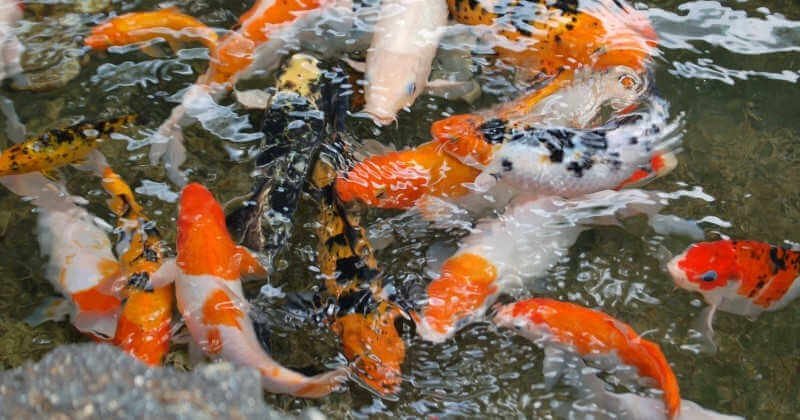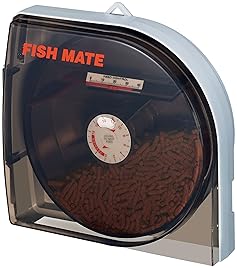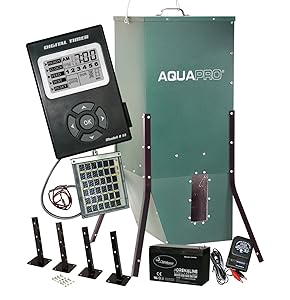Koi and goldfish learn to depend on their caretakers for food. Even though your pond fish scavenge on natural foods like algae, insects and worms, commercial food pellets and sticks ensure they always receive the proper nutrition.

The koi and goldfish we purchase for our ponds and water gardens are not wild fish. They are raised in commercial hatcheries and raised on high-quality commercial feeds.
The fish do eat natural foods but in order to have the fish grow quickly, develop beautiful coloration and fins and protect against nutrient deficiencies, the fish are carefully fed a balanced, vitamin and mineral-rich diet. Proteins, fat and fiber are also scientifically calculated and blended into the fish food recipe.
Most people keep colorful koi and goldfish in their backyard ponds. Special foods have been created that are easily digested and meet the nutritional needs of ornamental fish. Gamefish like bass, catfish and trout have different nutritional needs and are fed commercial gamefish diets. Ornamental koi and goldfish feeds come in several types:
- Floating pellets,
- Sinking pellets,
- Slow-sinking pellets,
- Floating sticks,
- Sinking sticks,
- Flakes.
These feed types are offered in a variety of special blends:
- Goldfish color enhancing,
- Goldfish growth,
- Fancy goldfish color boosting,
- Fancy goldfish fin development,
- Koi growth,
- Koi color enhancement,
- Cool water formulations,
- Warm water formulations.
You’ll also find general pond fish foods that are suitable for koi and goldfish. When selecting food pellets and sticks, make sure that the size of the food is small enough for the fish to eat. Pellets and sticks are made in several sizes. If you have small fish, go with a smaller food. Large koi will gobble down larger pellets and sticks while small fish will struggle to eat them.
The problem with over-feeding
How to feed goldfish and koi
Top Rated Automatic Feeders for Pond Fish
Automatic fish feeders are devices that will periodically dispense pelleted or stick foods into the pond. You designate the frequency of feeding and specify the amount of food dispensed with each feeding. Automatic feeders are used primarily to feed pond fish when a person is traveling on business or vacation. Neighbors and friends often feed too much or forget to feed altogether.
Pond feeders are also helpful if you want to feed several times throughout the day. There are many different types of automatic pond feeders. Some are relatively small and meant to be used only while you’re on vacation. Others are designed to be used continuously and hold several pounds of food. We’ll take a look at the top feeders and help you decide which one is best for you.
1. Fish Mate P7000 Pond Feeder
The P7000 automatic pond feeder by Fish Mate is a stand-alone hopper-style feeder.
The plastic construction is weather resistant and won’t rust.
The plastic see-through food hopper holds 6.5 pounds or about 30 cups of sticks or pellet food.
The easy to use LCD display makes setting up the feeding schedule easy.
The feeder uses four “C” batteries that will last from six to nine months before needing replacement.
The feeder is placed next to the pond, where food drops into the water from the dispensing chute. It can be attached to a larger base to prevent tip-overs from wind or curious children or animals.
Pros
- Variable feed portions from three teaspoons upward.
- Transparent hopper makes checking food level easy.
- Lid snaps on for a tight seal.
- Not too large.
- Does not require suspension over the pond.
Cons
- None.
2. Moultrie FeedCaster
The FeedCaster is a heavy-duty professional fish feeder.
It is not for small backyard ponds and water gardens.
The feeder consists of a 6.5-gallon metal drum that must be suspended above the water.
The drum will hold up to 50 pound of fish food. The motorized feeding device blasts food pellets out at a distance of up to 25 feet in a narrow throw pattern.
The motor is powered by a powered by a six-volt battery. An optional solar panel can be used to power the feeder. The feeding cycle is programmable for up to six times a day, for a duration from 1 to 20 seconds.
Pros
- Heavy duty pro-quality automatic feeder.
- Long throw for feeding fish in very large ponds.
- High capacity drum holds a lot of food.
- Made for use outdoors.
- Can be powered with an optional solar panel.
Cons
- Heavy when filled with food.
- Not for backyard ponds.
3. Fish Mate Automatic Pond Fish Feeder
Fish Mate has been manufacturing automatic feeds for over 30 years.
The P21 feeder is designed for smaller ponds. The P21 will feed the fish daily over a period of several hours.
The hopper holds enough food for about 21 days.
It uses a quartz timer that is powered by an AA battery. An indicator shows the condition of the battery.
The fully weatherproofed feeder may be pole-mounted at water’s edge or suspended over the pond.
Pros
- Reliable and accurate quartz timer.
- Waterproof construction.
- Operates for 1 year using a single AA battery.
- Battery condition indicator.
- Food capacity of approximately 21 daily meals.
- Fish are fed over several hours reducing danger of overfeeding.
- Feed quantity is adjustable.
Cons
- Reliability is not consistent unit to unit.
4. Koi Cafe Automatic Koi Feeder
The Koi Café automatic feeder is constructed of galvanized steel for weather resistance and long service life.
The feeding mechanisms is powered by a rechargeable 6-volt battery.
An optional solar charger can also be used. Feeding is set by adjusting the feed flow lever and determining the number of seconds per feeding per cycle.
The premium digital timer lets you set a feeding schedule up to five times per day. The built-in food level window makes checking the feed level easy.
The Koi Cafe automatic fish feeder holds 4 to 6 lbs. of koi food.
The feeder comes with a built-in solar panel but you’ll have to purchase the charger unit to use the solar power capabilities. The feeder drops food out of the bottom of the unit, so it must be suspended above the water.
Pros
- Solid metal construction.
- Holds a reasonable amount of pellets or sticks.
- Easy to use timer.
- Optional solar charger.
Cons
- Must be suspended over the pond.
5. Wildgame Innovations low profile directional fish feeder kit
The Wildgame Innovations fish feeder hold up to 75 pounds of fish food.
The extra-large food hopper can be suspended above the pond or placed on a dock or feeding station near the water.
Heavy-duty legs support the feeder for stand-alone operation.
This automatic feeder is intended for lakes or very large ponds.
The feeder requires assembly and wiring before use. Food pellets are broadcast up to 75 feet from the food hopper. The kit includes a 12-volt battery, charger and solar panel.
Pros
- Large capacity food hopper.
- Heavy, metal construction.
- Comes complete with charger.
Cons
- Feeding mechanism clogs with food pellets.
- Moisture collects near the motor and gets gummy with food dust.
- Timer is unreliable.
Final recommendations
For smaller goldfish and koi ponds the Fish Mate P7000 is recommended. The hopper holds just the right amount of food and does not need to be suspended above the water. The feeder blends into the landscape and is not too heavy to move around for maintenance and battery changes.
For large koi ponds that require heavy feeding, consider the Koi Café. With all-metal construction and large capacity hopper, it can handle hungry koi. The bottom-drop mechanism requires the feeder to be suspended over the water but should not be an issue with large ponds.
The professional broadcasting feeder are better suited for natural ponds and fish farms.




